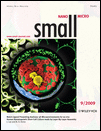A Simple Top-Down/Bottom-Up Approach to Sectored, Ordered Arrays of Nanoscopic Elements Using Block Copolymers
Abstract
A top-down/bottom-up approach is demonstrated by combining electron-beam (e-beam) lithography and a solvent annealing process. Micellar arrays of polystyrene-block-poly(4-vinylpyridine) (PS-b-P4VP) with a high degree of lateral order can be produced on a surface where sectoring is defined by e-beam patterning. The e-beam is used to crosslink the block copolymer (BCP) film immediately after spin-coating when the BCP is disordered or in a highly ordered solvent-annealed film. Any patterns can be written into the BCP by crosslinking. Upon exposure to a preferential solvent for the minor component block followed by drying, cylindrical nanopores are generated within the nonexposed areas by a surface reconstruction process, while, in the exposed areas, the films remain unchanged. Nickel nanodot arrays can be placed over selected areas on a surface by thermal evaporation and lift-off process.




